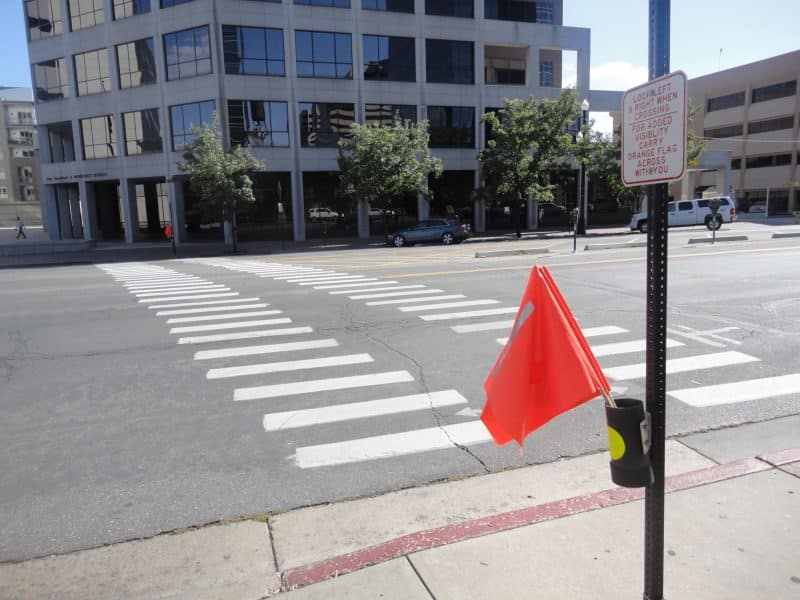 In what we can only hope is not a preview to the coming summer, an altercation between a driver and pedestrian came to blows on July 16th last year. When a 50-year-old man crossing just outside a crosswalk gestured rudely at the 63-year-old driver who refused to slow down for him, the driver deferred his journey for long enough to deliver a few clouts to the pedestrian’s face. (A witness claimed that both men were violent, but Park City police officer Phil Kirk claims that only the pedestrian was hurt, and only the driver was charged with assault.)
In what we can only hope is not a preview to the coming summer, an altercation between a driver and pedestrian came to blows on July 16th last year. When a 50-year-old man crossing just outside a crosswalk gestured rudely at the 63-year-old driver who refused to slow down for him, the driver deferred his journey for long enough to deliver a few clouts to the pedestrian’s face. (A witness claimed that both men were violent, but Park City police officer Phil Kirk claims that only the pedestrian was hurt, and only the driver was charged with assault.)
Tension between drivers and pedestrians rarely reaches such a pitch; however, interaction between them is a long way from ideal in Utah: car crashes may be on the decline, but pedestrian deaths are becoming more frequent. In 2011, Utah saw the highest rate of pedestrian hits, injuries, and fatalities in 10 years.
Unless it is your practice to duke it out with random strangers whose actions put you off, statistics show that many of these accidents can be avoided. To deflect the hazards that most often lead to pedestrian accidents, take the following advice:
Table of Contents
For Pedestrians:
1. Don’t jaywalk.
Yes, drivers are obliged to drive the speed limit, keep their eyes on the road, etc. specifically to avoid hitting you. That doesn’t mean it isn’t rude to test both drivers and your guardian angel by darting out into the road without warning. According to the Utah Department of Health, 16% of pedestrian accidents involve “improper crossing;” and an additional 9% are due to “darting.” Furthermore, surprising a driver puts them at risk for sustaining harm when they try to avoid you. Ergo, making use of subsidized crossing signals is the best policy.
2. Use pedestrian flags
Pedestrian flags may look a little dorky, but using them is a courtesy to drivers when the light is dim. In fact, the flags are also useful when it’s very bright—the extra waving, alone increases your visibility. You’re far more likely to attract a driver’s gaze with them than without; and in any case, they work better than the obscene gesture utilized in the aforementioned story.
3. Watch for trains.
With the implementation of FrontRunner, another kind of pedestrian accident is gaining ground in Utah: train accidents. Utahns who are unfamiliar with the risks posed by trains are in particular danger of falling victim to their own misjudgment. Although the posted rules and restricted areas may seem severe, the truth is that trains can, for all their volume, catch pedestrians by surprise, as several recent tragedies prove. However paranoid it may seem to obey posted warnings, you do not want to mess with anything as big and fast as a train.
For Drivers:
1. Yield the right of way.
A tip like this should never have become an item on this list; yet, failure to yield the right of way is the leading cause of pedestrian accidents in the state, precipitating 16% of fatal and injurious accidents. Drivers wanting to do their part to reduce Utah’s traffic casualties can start by not ignoring the obvious. (Hint: Yielding the right of way also prevents roughly every other kind of traffic accident.)
2. Pay Attention.
About 10% of pedestrian accidents in Utah are distracted driving accidents. Stories about “idiots” with cell phones, drinks, and other things that have no place in cars that hit pedestrians crossing at a crosswalk are fairly common. You wouldn’t operate a pair of scissors without looking at them; it makes even less sense to drive without watching the road.
3. Don’t speed
Speeding contributes to 32% of all accidents. In Utah, 84% of pedestrian accidents occurred in areas where the speed limit was between 20 and 45 miles per hour—speeds at which it is very easy to come to a full stop quickly if you watch where you’re going. You may rationalize that pedestrians should simply refrain from jaywalking (and they should); but such justifications seem hollow after you’ve hit someone.
As the statistics complied by the state of Utah indicate, most pedestrian accidents are extremely preventable. However, when they are not actually prevented, there is often little enough excuse for it that the victims are entitled to compensation from their insurance companies and/or the at-fault party. Those injured in pedestrian accidents in Utah may contact personal injury attorneys Good Guys Injury Law for legal guidance at no initial cost by calling (801) 506-0800.
Image courtesy of Paul Sableman